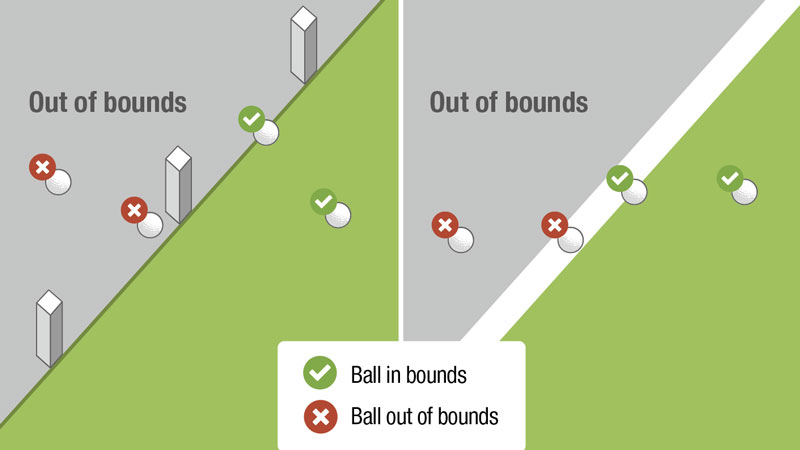Rules Of Golf: Out Of Bounds
When is your ball in or out of bounds, and what should you do? Find out here...


However good you are, at some stage you will hit your ball beyond the course boundaries, so you need to know what to do when you find yourself out of bounds
Rules Of Golf: Out Of Bounds
Out of bounds may be defined in a number of ways – white stakes, lines on the ground, fences, walls, railings – but if your ball has strayed beyond them, the first thing to remember is that there is no option within the Rules to drop a ball under penalty at the point where your ball crossed the OOB line as you would with a water hazard (although many golfers might play this ‘rule’ informally in friendly games).
If your ball is definitely out of bounds, you must play another ball from where you last played under penalty of stroke and distance (Rule 14.6), whether from the tee or fairway. So if it was your tee-shot that had gone OOB, you would now be playing three off the tee.
If there is some doubt as to whether or not the ball is out of bounds (i.e the out of bounds line is partially hidden by trees, or you cannot be 100% certain it has definitely crossed the line) make sure you declare your next shot a provisional ball, for if you fail to do so, you won’t be able to continue with the original ball even if it is found in bounds.
Watch: 8 rules golfers break without realising
Rule 18.2 then defines what is deemed in or out of bounds.
Get the Golf Monthly Newsletter
Subscribe to the Golf Monthly newsletter to stay up to date with all the latest tour news, equipment news, reviews, head-to-heads and buyer’s guides from our team of experienced experts.

A ball is in bounds when any part of the ball:
- Lies on or touches the ground or anything else (such as any natural or artificial object) inside the boundary edge, or
- Is above the boundary edge or any other part of the course.
Where out of bounds is defined by white stakes or a fence, the out of bounds line is the nearest inside points at ground level of the stakes or fence posts.
When a line on the ground is used, the line itself is out of bounds. However, a ball is deemed in bounds still even if only a small part of it lies on the course side of the boundary line.
If white stakes are used at intervals, the out of bounds line is the direct line from one stake to the next.
Clearly this may sometimes become a matter of tricky judgment with the naked eye, but it is not unknown for referees in big events to carry a piece of string around with them to help them determine if a ball lies in or out of bounds!
Related: 7 tips to help you find your golf ball
Other important out of bounds points to note are:
1) You may stand out of bounds to play a ball that is lying in bounds.

2) The out of bounds line extends vertically upwards, so if your ball is lodged in a tree on the boundary, you will have to make your judgment on that basis.
3) Whatever is used to define out of bounds - whether fence, railings, wall or stakes – is deemed to be fixed and is not classed as an obstruction. This means that you get no free relief if the fence, railings or wall impede your stance, backswing or follow-through, and that white out of bounds stakes may not be removed to facilitate your next shot.
4) Some courses have ‘internal out of bounds’ for reasons of safety or to ensure a hole is played in the way in which it was designed rather than via another potentially easier route down another fairway. Whatever you think of that, you have to honour it even if your ball is lying in the clear with a perfect route in to the green. Frustrating sometimes, but probably for the overall good of all playing the course!
For more rules content, check out the Golf Monthly website.

Jeremy Ellwood has worked in the golf industry since 1993 and for Golf Monthly since 2002 when he started out as equipment editor. He is now a freelance journalist writing mainly for Golf Monthly. He is an expert on the Rules of Golf having qualified through an R&A course to become a golf referee. He is a senior panelist for Golf Monthly's Top 100 UK & Ireland Course Rankings and has played all of the Top 100 plus 91 of the Next 100, making him well-qualified when it comes to assessing and comparing our premier golf courses. He has now played 1,000 golf courses worldwide in 35 countries, from the humblest of nine-holers in the Scottish Highlands to the very grandest of international golf resorts. He reached the 1,000 mark on his 60th birthday in October 2023 on Vale do Lobo's Ocean course. Put him on a links course anywhere and he will be blissfully content.
Jezz can be contacted via Twitter - @JezzEllwoodGolf
Jeremy is currently playing...
Driver: Ping G425 LST 10.5˚ (draw setting), Mitsubishi Tensei AV Orange 55 S shaft
3 wood: Srixon ZX, EvenFlow Riptide 6.0 S 50g shaft
Hybrid: Ping G425 17˚, Mitsubishi Tensei CK Pro Orange 80 S shaft
Irons 3- to 8-iron: Ping i525, True Temper Dynamic Gold 105 R300 shafts
Irons 9-iron and PW: Honma TWorld TW747Vx, Nippon NS Pro regular shaft
Wedges: Ping Glide 4.0 50˚ and 54˚, 12˚ bounce, True Temper Dynamic Gold 105 R300 shafts
Putter: Kramski HPP 325
Ball: Any premium ball I can find in a charity shop or similar (or out on the course!)
-
 Rory McIlroy vs Bryson DeChambeau: Who Are We Picking To Win The 2025 Masters?
Rory McIlroy vs Bryson DeChambeau: Who Are We Picking To Win The 2025 Masters?We're set up for a blockbuster final day at Augusta National where Rory McIlroy and Bryson DeChambeau play together in the final group
By Elliott Heath Published
-
 The Masters Crystal Rory McIlroy Has Already Won At Augusta National This Week
The Masters Crystal Rory McIlroy Has Already Won At Augusta National This WeekMcIlroy leads going in to the final round at Augusta National, with the four-time Major winner already bagging some silverware before he looks to claim the Green Jacket
By Matt Cradock Published